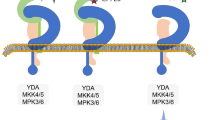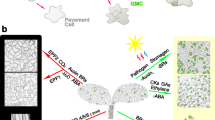Conclusion
To correlate the two sections of this review it appears that the stomatal mechanism is self regulatory. If, as above, we define the stomata as functioning when they are open and quiescent when they are closed,their principal function is to regulate that very factor which is presumed to regulate them, viz.the concentration of CO 2 in the leaf or, respectively, in the guard cells.
Similar content being viewed by others
Literature
The recent papers with which this review deals chiefly are
Sayre, J. D., “Physiology of Stomata of Rumex patientia”. Ohio Journal of Science,26, 233–266, 1926. Also Science,56, 205, 1923.
Scarth, G. W., “The influence of H-ion concentration on the turgor and movement of plant cells with special reference to stomatal behaviour”. International Congress of Plant Sciences, Ithaca, 1926, Proceedings (in press). Also Plant Physiology,1, 215–299, 1926.
The reviews to which the present one is supplementary are
Weber, F., „Enzymatische Regulation der Spaltöffnungsbewegung”. Die Naturwiss.,17, 309–316, 1923.
— „Die Schließzellen”. Arch. f. exper. Zellforsch.,3, 101–113, 1926.
The following list does not include papers already listed in the above reviews.
Alexandrow, W. G., Beiträge zur Kenntnis der Assimilationstätigkeit der grünen Plastiden. Ber. Deutsch. Bot. Ges.,43, 325–332, 1925.
Bakke, A. L., Determination of Wilting. Bot. Gaz.,66, 81–116, 1918.
Blackman, F. F., On the path of gaseous exchange between aerial leaves and the atmosphere. Phil. Trans, Roy. Soc.,186 B, 505, 1895.
— Optima and limiting factors. Ann. Bot.,19, 281–295, 1905.
Blackman, V. H. andKnight, R. C., A method of controlling the rate of air movement in transpiration experiments. Ann. Bot.,31, 217–220, 1917.
Brown, H. T. andEscombe, F., Static diffusion of gases and liquids in relation to the assimilation carbon and translocation in plants. Phil. Trans. Roy. Soc., 190 B, 223–291, 1900; also Ann. Bot.,14, 537–542, 1900.
Clum, H. H., The effect of transpiration and environmental factors on leaf temperatures. Am. J. Bot.,13, 194–230, 1926.
Darwin, F., Observation on Stomata. Phil. Trans. Roy. Soc.,190 B, 531–621, 1898.
—, The effect of light on the transpiration of leaves. Proc. Roy. Soc.,87 B, 281–299, 1914.
— andPertz, D. M., A new method of estimating the aperture of stomata. Proc. Roy. Soc.,84 B, 136–154, 1912.
Delf, E. M., Transpiration and the behaviour of stomata in Halophytes. Ann. Bot.,25, 485–505, 1911.
— Transpiration in succulent plants. Ann. Bot.,26, 409–442, 1912.
Iljin, W. S., Über den Einfluß des Welkens der Pflanzen auf die Regulierung der Spalt- öffnungen. Jahrb. f. wiss. Bot.,61, 670–697, 1922.
— The influence of salts on the alternation of concentration of cell sap in plants. Stud. plant-physiol. Lab. Prague, 2.
Jeffreys, Harold, Some problems of evaporation. Phil. Mag.,35, 270–280, 1918.
—, On transpiration from leaf stomata. Phil. Mag.,35, 431–433, 1918.
Knight, R. C., On the use of the porometer in stomatal investigation. Ann. Bot.,30, 57–76, 1916.
— The inter-relations of stomatal aperture, leaf water content and transpiration rate. Ann. Bot.,31, 221–240, 1917.
— Further observations on the transpiration, stomata, leaf water content, and wilting of plants. Ann. Bot,36, 361–383, 1922.
Kiesselbach, T. A., Transpiration as a factor in crop production. Bull. Nebr. Agr. Exp. Sta. Res.,6, 170, 1916.
Laidlaw, C. G. P. andKnight, R. C., A description of a recording porometer and a note on stomatal behaviour during wilting. Ann. Bot,30, 47–56, 1916.
Larmor, Joseph, On transpiration through leaf stomata. Phil. Mag.,35, 350–352, 433–434, 1918.
Linsbauer, K., Beobachtungen an Spaltöffnungen. Planta,2 (4/5), 530–536, 1926.
— Weitere Beobachtungen an Spaltöffnungen. Planta3, 527–561, 1927.
Livingston, B. E. andBrown, W. H., Relations of the daily march of transpiration to variations in the water content of the leaves. Bot. Gaz.,53, 305–330, 1912.
Livingston, B. E. andEastbrook, A. H., Observations on the degree of stomatal movement in certain plants. Bull. Torr. Club,39, 15–22, 1912.
Lloyd, F. E., The Physiology of Stomata. Carnegie Inst. Wash. Pub., No. 82, 1908.
— The relation of transpiration and stomatal movement to the water content of leaves. in Fouquieria splendens. Plant World,15, 1–9, 1912.
— Leaf water and stomatal movement in Gossypium and a method of direct visual observation of stomatain situ. Bull. Torr. Bot. Club,40, 1–26, 1913.
Maximow, N. A., The physiological basis of drought resistance in plants. Leningrad, 1926, English Abstract.
Mendiola, N. B., Effects of different rates of transpiration on the dry weight and ash content of the Tobacco Plant. Philipp. Jour. Sc.,20, 639–655, 1922.
Muenscher, W. C., The effect of transpiration on the absorption of salts by plants. Am. J. Bot.,9, 311–329, 1922.
Nikolic, M., Über die Beziehung der Stomatärbewegung zur Lichtintensität. Beih. z. Bot. Centralbl. Abt. 1,41, 327–346, 1925.
Renner, O., Beiträge zur Physik der Transpiration. Flora,100, 451–547, 1910.
— Zur Physik der Transpiration. Ber. d. deutsch. Bot Gesellsch.,29, 125–132, 1911;30, 572–580, 1912.
Richter, A. A. undDworetkaja, E. J., Zur Frage Über den Mechanismus der Schließ-zellen. II. Saratow, 1926. (Russian.)
Scarth, G. W., The mechanism of the accumulation of dyes by living cells. Plant Physiol.,1, 215–229, 1926.
Shreve, E. B., The daily march of transpiration in a desert perennial. Carn. Inst. Wash. Pub., No. 194.
Skene, M., The Biology of Flowering Plants. London, 1924.
Strugger, S. andWeber, F., Stärkeabbau in Mesophyll und Schließzellen. Ber. d. deutsch. Bot. Gesellsch.,43, 431–438, 1925.
— — Zur Physiologie der Stomata-Nebenzellen. Ibid.,44, 272–278, 1926.
Thoday, D, Experiments on assimilation in the open air. Proc. Roy. Soc.,82 B, 421–450, 1910.
Trelease, S. F. andLivingston, B. E., The daily march of transpiring power as indicated by the porometer and standardised hygrometric paper. Jour. Ecol.,4, 1, 1916.
Weber, F., Hitzeresistenz funktionierender Stomata-Nebenzellen. Planta,2 (4/5), 669–677, 1926.
—, Cytoplasma- und Kern-Zustandsänderungen bei Schließzellen. Protoplasma2, 305–311, 1927.
— Stomata-öffnen welkender Blätter. Ber. deutsch. Bot. Ges.45, 1927 (in press).
Author information
Authors and Affiliations
Rights and permissions
About this article
Cite this article
Scarth, G.W. Stomatal movement: Its regulation and regulatory rÔle a review. Protoplasma 2, 498–511 (1927). https://doi.org/10.1007/BF01604752
Received:
Published:
Issue Date:
DOI: https://doi.org/10.1007/BF01604752




